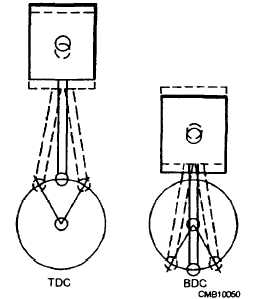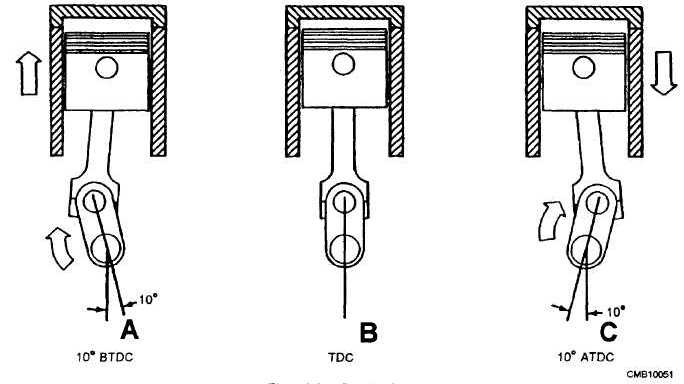after top dead center (ATDC). The other period begins approximately 15 to 20 degrees before bottom dead center (BBDC) and ends approximately 15 to 20 degrees after bottom dead center (ABDC). These two positions are shown in figure 2-30. These positions are commonly referred to as ROCK POSITIONS
IGNITION TIMING
(fig. 2-31) refers to the timing of the spark plug firing with relation to the piston position during compression and power strokes. The ignition system is timed, so the spark occurs before the piston reaches TDC on the compression stroke. This gives the mixture enough time to ignite and start burning.
If this time were not provided - that is, if spark occurred at or after TDC - then the pressure increases would take place too late to provide a full-power stroke.
In figure 2-31, view A, the spark occurs at 10 degrees before top dead center; view B, the spark occurs at top dead center; and view C, the spark occurs at 10 degrees after top dead center.
At higher speeds, there is still less time for the air- fuel mixture to ignite and burn. The ignition system includes both the vacuum and mechanical advance mechanisms that alter ignition timing to compensate for this and avoid power loss, as engine speeds increases.
Q11. One foot-pound of work is equivalent to lifting 1 pound what distance?

Figure 2-30. - Rock position.
Q12. What device uses a flywheel to measure actual usable horsepower?
Q13. What term is used for resistance to motion?
Q14. The relationship between actual power produced by an engine and actual power delivered to the crankshaft is known by what term?
Q15. What metric unit of measurement is used to express engine displacement?

Figure 2-31. - Ignition timing.
Continue Reading